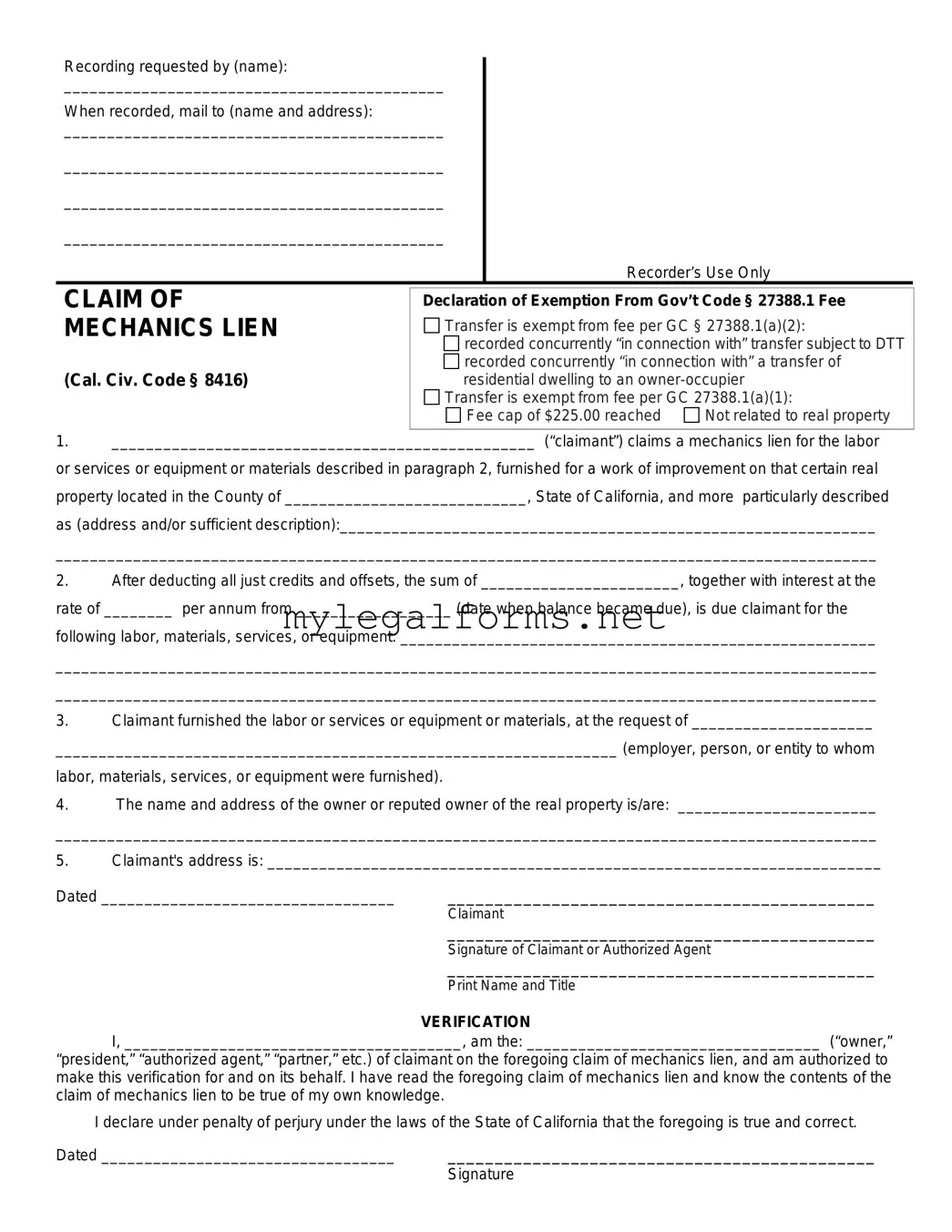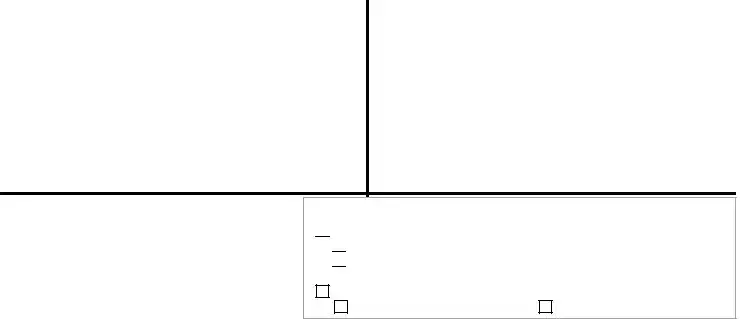Recording requested by (name):
____________________________________________
When recorded, mail to (name and address):
____________________________________________
____________________________________________
____________________________________________
____________________________________________
Recorder’s Use Only
CLAIM OF MECHANICS LIEN
(Cal. Civ. Code § 8416)
Declaration of Exemption From Gov’t Code § 27388.1 Fee

 Transfer is exempt from fee per GC § 27388.1(a)(2):
Transfer is exempt from fee per GC § 27388.1(a)(2):

 recorded concurrently “in connection with” transfer subject to DTT
recorded concurrently “in connection with” transfer subject to DTT

 recorded concurrently “in connection with” a transfer of residential dwelling to an owner-occupier
recorded concurrently “in connection with” a transfer of residential dwelling to an owner-occupier
Transfer is exempt from fee per GC 27388.1(a)(1):
Fee cap of $225.00 reached |
Not related to real property |
1._________________________________________________ (“claimant”) claims a mechanics lien for the labor or services or equipment or materials described in paragraph 2, furnished for a work of improvement on that certain real property located in the County of ____________________________, State of California, and more particularly described as (address and/or sufficient description):______________________________________________________________
_______________________________________________________________________________________________
2.After deducting all just credits and offsets, the sum of _______________________, together with interest at the rate of ________ per annum from __________________ (date when balance became due), is due claimant for the following labor, materials, services, or equipment: _______________________________________________________
_______________________________________________________________________________________________
_______________________________________________________________________________________________
3.Claimant furnished the labor or services or equipment or materials, at the request of _____________________
_________________________________________________________________ (employer, person, or entity to whom labor, materials, services, or equipment were furnished).
4.The name and address of the owner or reputed owner of the real property is/are: _______________________
_______________________________________________________________________________________________
5.Claimant's address is: _______________________________________________________________________
Dated __________________________________ _____________________________________________
Claimant
_____________________________________________
Signature of Claimant or Authorized Agent
_____________________________________________
Print Name and Title
VERIFICATION
I, _______________________________________, am the: __________________________________ (“owner,”
“president,” “authorized agent,” “partner,” etc.) of claimant on the foregoing claim of mechanics lien, and am authorized to make this verification for and on its behalf. I have read the foregoing claim of mechanics lien and know the contents of the claim of mechanics lien to be true of my own knowledge.
I declare under penalty of perjury under the laws of the State of California that the foregoing is true and correct.
Dated __________________________________ _____________________________________________
Signature
NOTICE OF MECHANICS LIEN CLAIM
ATTENTION!
Upon the recording of the enclosed MECHANICS LIEN with the county recorder's office of the county where the property is located, your property is subject to the filing of a legal action seeking a court-ordered foreclosure sale of the real property on which the lien has been recorded. That legal action must be filed with the court no later than 90 days after the date the mechanics lien is recorded.
The party identified in the enclosed mechanics lien may have provided labor or materials for improvements to your property and may not have been paid for these items. You are receiving this notice because it is a required step in filing a mechanics lien foreclosure action against your property. The foreclosure action will seek to pay for unpaid labor, materials, or improvements provided to your property. This may affect your ability to borrow against, refinance, or sell the property until the mechanics lien is release.
BECAUSE THE LIEN AFFECTS YOUR PROPERTY, YOU MAY WISH TO SPEAK WITH YOUR CONTRACTOR IMMEDIATELY, OR CONTACT AN ATTORNEY, OR FOR MORE INFORMATION ON MECHANICS LIENS GO TO THE CONTRACTORS' STATE LICENSE BOARD WEB SITE AT www.cslb.ca.gov.
PROOF OF SERVICE AFFIDAVIT
California Civil Code section 8416
Failure to serve the Mechanic’s Lien and Notice of Mechanic’s Lien on the owner, or alternatively if the owner cannot be served on the lender or direct contractor, shall cause the Mechanic’s Lien to be unenforceable as a matter of law (Civil Code Section 8024(d)). Service of the Mechanic’s Lien and Notice of Mechanic’s Lien must be by (1) registered mail, (2) certified mail, or (3) first-class mail evidenced by a certificate of mailing, postage prepaid, and to a residence or business address for the owner, lender or contractor. Further, a Proof of Service Affidavit (below) must be completed and signed by the person serving the Mechanic’s Lien and Notice of Mechanic’s Lien. This page should be completed (either one of the sections below) and recorded with the County Recorder along with the Mechanic’s Lien and Notice of Mechanic’s Lien.
PROOF OF SERVICE AFFIDAVIT (ON OWNER)
California Civil Code section 8416(a)(7) and (c)(1)
I, ______________________________ (name), declare that I served a copy of this Mechanic’s Lien and
Notice of Mechanic’s Lien by registered mail, certified mail, or first-class mail evidenced by a certificate of mailing, postage prepaid, addressed as follows to the owner(s) or reputed owner(s) of the property:
Company/Person Served: ________________________________________________________________
Title or capacity of person served (if appropriate): ______________________________________________
Service address: ________________________________________________________________________
Said service address is the owner’s residence, place of business, or address showed by the building permit on file with the permitting authority for the work.
Executed on ___________, 20_____ (date) at __________________ (city), _____________________
(county), California.
By: _____________________________________
(Signature of person making service)
ALTERNATE PROOF OF SERVICE AFFIDAVIT (ON LENDER OR DIRECT CONTRACTOR)
California Civil Code Section 8416(a)(7) and (c)(2)
I, ____________________________________________________ (name), declare that the owner or
reputed owner cannot be served with a copy of this Mechanic’s Lien and Notice of Mechanic’s Lien by registered mail, certified mail, or first-class mail. Pursuant to California civil Code section 8416(c )(2), I served a copy of this Mechanic’s Lien and Notice of Mechanic’s Lien by registered mail, certified mail, or first-class mail evidenced by a certificate of mailing, postage prepaid, addressed as follows to the construction lender or direct contractor as follows:
Company/Person Served: ________________________________________________________________
Title or capacity of person served (if appropriate): ______________________________________________
Service address: ________________________________________________________________________
Executed on ___________, 20_____ (date) at __________________ (city), _____________________
(county), California.
By: _____________________________________
(Signature of person making service)



 Transfer is exempt from fee per GC § 27388.1(a)(2):
Transfer is exempt from fee per GC § 27388.1(a)(2):
 recorded concurrently “in connection with” transfer subject to DTT
recorded concurrently “in connection with” transfer subject to DTT
 recorded concurrently “in connection with” a transfer of residential dwelling to an
recorded concurrently “in connection with” a transfer of residential dwelling to an 